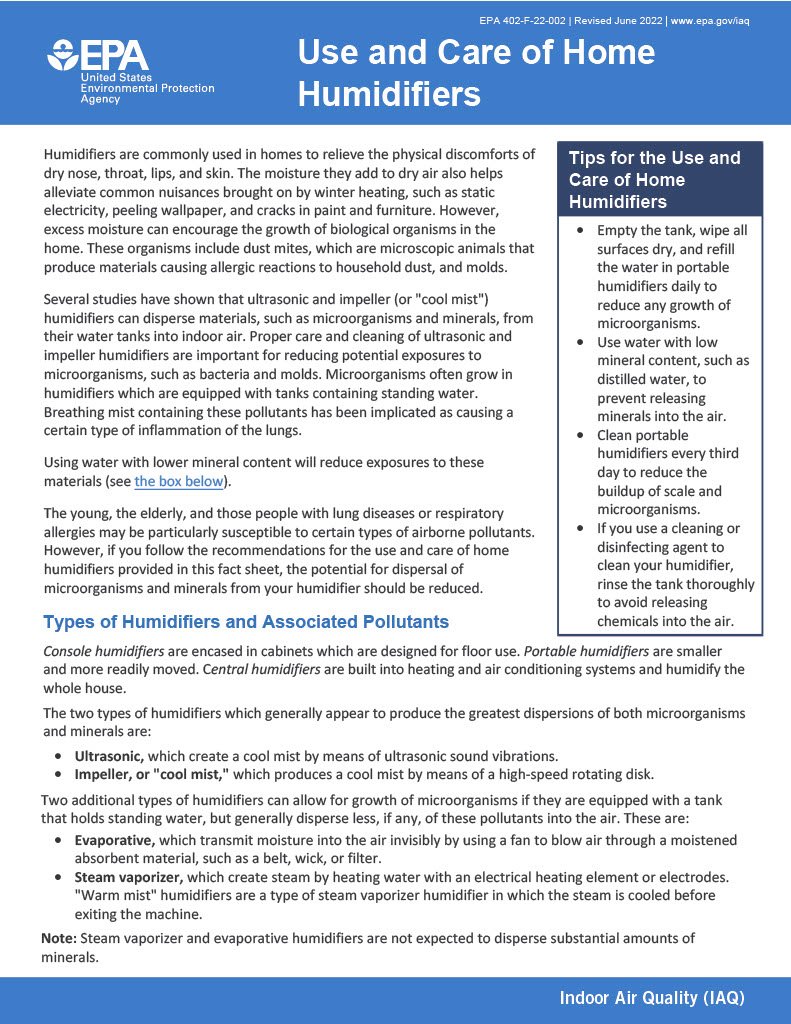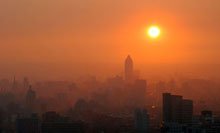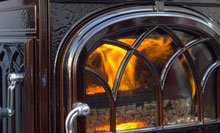Asthma Triggers: Gain Control
Información disponible en español
Americans spend up to 90 percent of their time indoors, and indoor allergens and irritants play a significant role in triggering asthma attacks. Triggers are things that can cause asthma symptoms, an episode or attack or make asthma worse. If you have asthma, you may react to just one trigger or you may find that several things act as triggers. Be sure to work with a doctor to identify triggers and develop a treatment plan that includes ways to reduce exposures to your asthma triggers.
On this page:
- Secondhand Smoke
- Dust Mites
- Molds
- Cockroaches and Pests
- Pets
- Nitrogen Dioxide
- Outdoor Air Pollution
- Chemical Irritants
- Wood Smoke
On other pages:
- Download infographics for each asthma trigger.
- Find resources for parents, caregivers, kids and healthcare professionals.
- Find asthma publications.
Secondhand Smoke
About Secondhand Smoke and Asthma

Secondhand smoke is the smoke from a cigarette, cigar, or pipe, that is exhaled by a smoker. Secondhand smoke contains more than 4,000 substances, including several compounds that cause cancer.
Secondhand smoke can trigger asthma episodes and increase the severity of attacks. Secondhand smoke is also a risk factor for new cases of asthma in pre-school-aged children. Children's developing bodies may make them more susceptible to the effects of secondhand smoke. Due to their small size, they breathe more rapidly than adults, thereby taking in more secondhand smoke. Children receiving high doses of secondhand smoke, such as those with smoking parents, run the greatest relative risk of experiencing damaging health effects.
Actions You Can Take
- Don't let anyone smoke near your child.
- If you smoke — until you can quit, don't smoke in your home or car.
Additional Resources
Dust Mites
About Dust Mites and Asthma

Dust mites are tiny bugs that are too small to see. Every home has dust mites. They feed on human skin flakes and are found in mattresses, pillows, carpets, upholstered furniture, bedcovers, clothes, stuffed toys, fabric, and fabric-covered items.
Body parts and droppings from dust mites can trigger asthma in individuals with allergies to dust mites. Exposure to dust mites can cause asthma in children who have not previously exhibited asthma symptoms.
Actions You Can Take
- Common house dust may also contain asthma triggers. These simple steps can help: wash bedding in hot water once a week, and dry completely.
- Use dust proof covers on pillows and mattresses.
- Vacuum carpets and furniture every week.
- Choose stuffed toys that you can wash. Wash stuffed toys in hot water. Dry completely before your child plays with the toy.
- Dust often with a damp cloth.
- Use a vacuum with a HEPA filter on carpet and fabric-covered furniture to reduce dust build-up. People with asthma or allergies should leave the area being vacuumed. Read more about Air Filters - Available Guide for their Comparison.
Additional Resources
- An Introduction to Indoor Air Quality: Biological Pollutants
- Help Your Child Gain Control Over Asthma
Molds
About Molds and Asthma

Molds create tiny spores to reproduce, just as plants produce seeds. Mold spores float through the indoor and outdoor air continually. When mold spores land on damp places indoors, they may begin growing. Molds are microscopic fungi that live on plant and animal matter. Molds can be found almost anywhere when moisture is present.
For people sensitive to molds, inhaling mold spores can trigger an asthma attack.
Actions You Can Take
- If mold is a problem in your home, you need to clean up the mold and eliminate sources of moisture.
- If you see mold on hard surfaces, clean it up with soap and water. Let the area dry completely.
- Use exhaust fans or open a window in the bathroom and kitchen when showering, cooking or washing dishes.
- Fix water leaks as soon as possible to keep mold from growing.
- Dry damp or wet things completely within one to two days to keep mold from growing.
- Maintain low indoor humidity, ideally between 30-50% relative humidity. Humidity levels can be measured by hygrometers, which are available at local hardware stores.
Additional Resources

A Brief Guide to Mold, Moisture and Your Home
This guide provides information and guidance for homeowners and renters on how to clean up residential mold problems and how to prevent mold growth.
Find more information from EPA's Mold and Moisture Program.

Flood Cleanup and the Air In Your Home
This booklet tells you how to clean up after a flood and how to prevent indoor air problems.

Use and Care of Home Humidifiers
This fact sheet explains that some types of home humidifiers can disperse microorganisms from their water tanks into the indoor air and describes the different types of humidifiers and provides recommendations for their use and maintenance.
Cockroaches and Pests
About Cockroaches, Other Pests and Asthma

Droppings or body parts of cockroaches and other pests can trigger asthma. Certain proteins are found in cockroach feces and saliva and can cause allergic reactions or trigger asthma symptoms in some individuals.
Cockroaches are commonly found in crowded cities and the southern regions of the United States. Cockroach allergens likely play a significant role in asthma in many urban areas.
Actions You Can Take
- Insecticides and pesticides are not only toxic to pests — they can harm people too. Try to use pest management methods that pose less of a risk. Keep counters, sinks, tables and floors clean and free of clutter.
- Clean dishes, crumbs and spills right away.
- Store food in airtight containers.
- Seal cracks or openings around or inside cabinets.
Additional Resources

Home Safe Home Poster (pdf) (320 KB)
Identify possible pest habitats in your home where pests may reside; eliminate the source while reducing pesticide risks.

Citizen's Guide to Pest Control and Pesticide Safety
This booklet summarizes what a pest is, what pesticides are and the many factors that should be considered when faced with pest challenges in your home and other environments.

Cockroach Prevention Activity Website for Kids
This website educates kids about cockroaches; their anatomy and where they like to set up their homes. Learn how to control these pests while reducing pesticide risks; roaches are often asthma triggers and shouldn’t be inside where you’re at.

Oregon State University and EPA: National Pesticide Information Center (NPIC)
The NPIC is open from 6:30AM to 4:30PM Pacific time, daily. Call toll-free at 1-800-858-7378, or contact them via e-mail npic@ace.orst.edu.
Pets
About Pets and Asthma

Proteins in your pet's skin flakes, urine, feces, saliva and hair can trigger asthma. Dogs, cats, rodents (including hamsters and guinea pigs) and other warm-blooded mammals can trigger asthma in individuals with an allergy to animal dander.
The most effective method to control animal allergens is to not allow animals in the home. If you remove an animal from the home, it is important to thoroughly clean the floors, walls, carpets and upholstered furniture.
Some individuals may find isolation measures to be sufficiently effective. Isolation measures that have been suggested include keeping pets out of the sleeping areas, keeping pets away from upholstered furniture, carpets and stuffed toys, keeping the pet outdoors as much as possible and isolating sensitive individuals from the pet as much as possible.
Actions You Can Take
- Find another home for your cat or dog.
- Keep pets outside if possible.
- If you have to have a pet inside, keep it out of the bedroom of the person with asthma.
- Keep pets off of your furniture.
- Use an air cleaner with a HEPA filter.
- Vacuum carpets and furniture when the person with asthma is not around.
Additional Resources
Nitrogen Dioxide
About Nitrogen Dioxide and Asthma

Nitrogen dioxide (NO2) is an odorless gas that can irritate your eyes, nose and throat and cause shortness of breath. Indoor NO2 can come from using appliances that burn fuels such as gas, kerosene and wood.
In people with asthma, exposure to low levels of NO2 may cause increased bronchial reactivity and make young children more susceptible to respiratory infections. Long-term exposure to high levels of NO2 can lead to chronic bronchitis. Studies show a connection between breathing elevated short-term NO2concentrations, and increased visits to emergency departments and hospital admissions for respiratory issues, especially asthma.
Actions You Can Take
Make sure all fuel-burning appliances are properly installed, used, and maintained following all manufacturer's instructions. If possible, use fuel-burning appliances that are vented to the outside.
- Gas cooking stoves: Install and use an exhaust fan vented to outdoors over gast stoves. Never use the stove to keep you warm or heat your house.
- Unvented heaters: Use the proper fuel and keep the heater adjusted the right way. Open a window when you are using the heater.
Additional Resources
Outdoor Air Pollution
About Outdoor Air Pollution and Asthma

When inhaled, outdoor pollutants and pollen can aggravate the lungs and lead to:
- Chest pain;
- Coughing;
- Digestive problems;
- Dizziness;
- Fever;
- Lethargy;
- Sneezing;
- Shortness of breath;
- Throat irritation; and/or
- Watery eyes.
Outdoor air pollution and pollen may also worsen chronic respiratory diseases, such as asthma.
Actions You Can Take
Get more information about ozone maps, air quality forecasts, ozone action days, and more.
Monitor the Air Quality Index (AQI) on your local weather report.
- Know when and where air pollution may be bad.
- Regular exercise is healthy. Check your local air quality to know when to play and when to take it a little easier.
- Schedule outdoor activities at times when the air quality is better. In the summer, this may be in the morning.
- Stay inside with the windows closed on high pollen days and when pollutants are high.
- Use a portable air cleaner or high-efficiency furnace or heating, ventilation, and air conditioning (HVAC) system to reduce the level of fine particles from the air inside your home.
- Remove indoor plants if they irritate or produce symptoms for you or your family.
- Pay attention to asthma warning signs. If you start to see signs, limit outdoor activity. Be sure to talk about this with your child's doctor.
Additional Resources

Why is Coco Orange?
A picture book for children with asthma and their caretakers.

EnviroFlash
The EnviroFlash website provides air quality information such as forecasts and action day notifications via email for your area of interest.
Chemical Irritants
About Chemical Irritants and Asthma

Chemical irritants are found in some products in your house and may trigger asthma. Your asthma or your child's asthma may be worse around products such as cleaners, paints, adhesives, pesticides, cosmetics or air fresheners. Chemical irritants are also present in schools and can be found in commonly used cleaning supplies and educational kits.
Chemical irritants may exacerbate asthma. At sufficient concentrations in the air, many products can trigger a reaction.
Actions You Can Take
If you find that your asthma or your child's asthma gets worse when you use a certain product, consider trying different products. If you must use a product, then you should:
- Make sure your child is not around.
- Open windows or doors, or use an exhaust fan.
- Always follow the instructions on the product label.
Additional Resources
Wood Smoke
About Wood Smoke and Asthma

Smoke from wood-burning stoves and fireplaces contains a mixture of harmful gases and small particles. Breathing these small particles can cause asthma attacks and severe bronchitis, aggravate heart and lung disease and may increase the likelihood of respiratory illnesses. If you're using a wood stove or fireplace and smell smoke in your home, it probably isn't working as it should.
Actions You Can Take
- To help reduce smoke, make sure to burn dry wood that has been split, stacked, covered and stored for at least 6 months.
- Have your stove and chimney inspected every year by a certified professional to make sure there are no gaps, cracks, unwanted drafts or to remove dangerous creosote
build-up. - If possible, replace your old wood stove with a new, EPA-certified heating appliance. Newer wood stoves are at least 50% more efficient and pollute 70% less than older models.
This can help make your home healthier and safer and help cut fuel costs.

